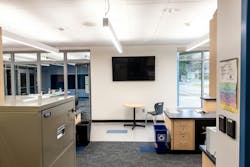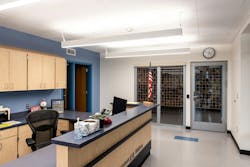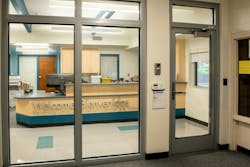Building Perimeters are Only One Layer in Safe School Design
While several states are taking the next steps to standardize safer school design, most of the proposed or passed laws focus on hardening the building’s exterior. Requiring bullet- or forced-entry-resistant materials in exterior doors and windows aligns with the Partner Alliance for Safer School (PASS) K-12 guidelines for the Building Perimeter Layer of a school security plan. While these updates to state building codes can contribute to safer school design, they are just one layer within those guidelines.
In Missouri, one state representative noted in response to a recent bill that people can still gain access to a space even if the exterior is hardened. This lawmaker brings up a valid concern. According to the U.S. Government Accountability Office, current or former students account for half of school shootings. This begs the question: if a person intent on violence can use their connection to a school to gain access, how can districts further enhance the level of protection their schools offer?
One answer is a multilayer approach to school security. If school administrators consider security measures that extend from the property line to within the classroom, then they can create several layers of protection, boosting the effectiveness of the entire approach. With this method, layers work to guard both their immediate and adjacent spaces. Consequently, it is important to consider not only each layer individually but also how they intersect and enhance the protections other layers offer as well.
Multifunctional, fire-rated glazing and the interior perimeter layer
The use of multifunctional, fire-rated glazing can meet current voluntary standards for hardening an entryway. It can also preserve safe egress during a fire. Further, multifunctional, fire-rated glazing can help specifiers meet best-practice recommendations for an individual layer while also supporting an adjacent layer. For example, the effectiveness of parking lot video surveillance can be increased with clear sightlines from the front office. Though current conversations have tended to focus on exterior doors and windows, multifunctional fire-rated glazing can be incorporated throughout the built environment to improve security without compromising a building’s ability to guard against fire.
The benefits of multifunctional glazing extend beyond visibility. According to the PASS K-12 guidelines, door vision panels and sidelites can help a school’s interior fulfill the highest security tiers when they include security-rated components. Using such glazing can complement a hardened building envelope by providing another layer of defense. However, it is important to note that some municipalities, Chicago for instance, require all components of a corridor to be fire-rated. If this is the case, then a system would need to offer both security and fire ratings.
The complication in these instances is that forced-entry and bullet-resistance rated products are often plastic-based. As such, they can burn at an intensity that exceeds those of standard testing protocols, potentially reducing an assembly’s effectiveness in a fire. Multifunctional, fire-rated glazing resolves this issue by using compatible products that are jointly tested to multiple standards.
Another concern is the dichotomy between lockdown and evacuation protocols. Fire alarms can be triggered (deliberately or inadvertently) during active shooter events. Having a fire barrier that doubles as a security barrier can allow occupants time to assess the situation and determine their best course of action—whether that is to shelter-in-place or evacuate.
Moving beyond the school building
Understanding how layering different security measures can compound their effectiveness is not without its nuance. If this is a goal of a school construction project, it is important that stakeholders consult with an Authority Having Jurisdiction (AHJ) and potentially security experts as well to ensure an architectural detail meets code requirements and works efficiently with other security measures.
That said, additions and expansions to model codes like the International Building Code (IBC) and the National Fire Protection Association (NFPA) 101 Life Safety Code could help streamline the process of enhancing school safety and security by giving designers and specifiers a standard to reference in a project’s planning phase.
If national model codes are expanded to include security, then it is important that new requirements do not forget about fire and life safety—especially since there are, on average, over 3,000 fires on school campuses annually. Standardizing the use of multifunctional, fire-rated glazing could help ensure occupants are guarded against several types of life safety threats.



